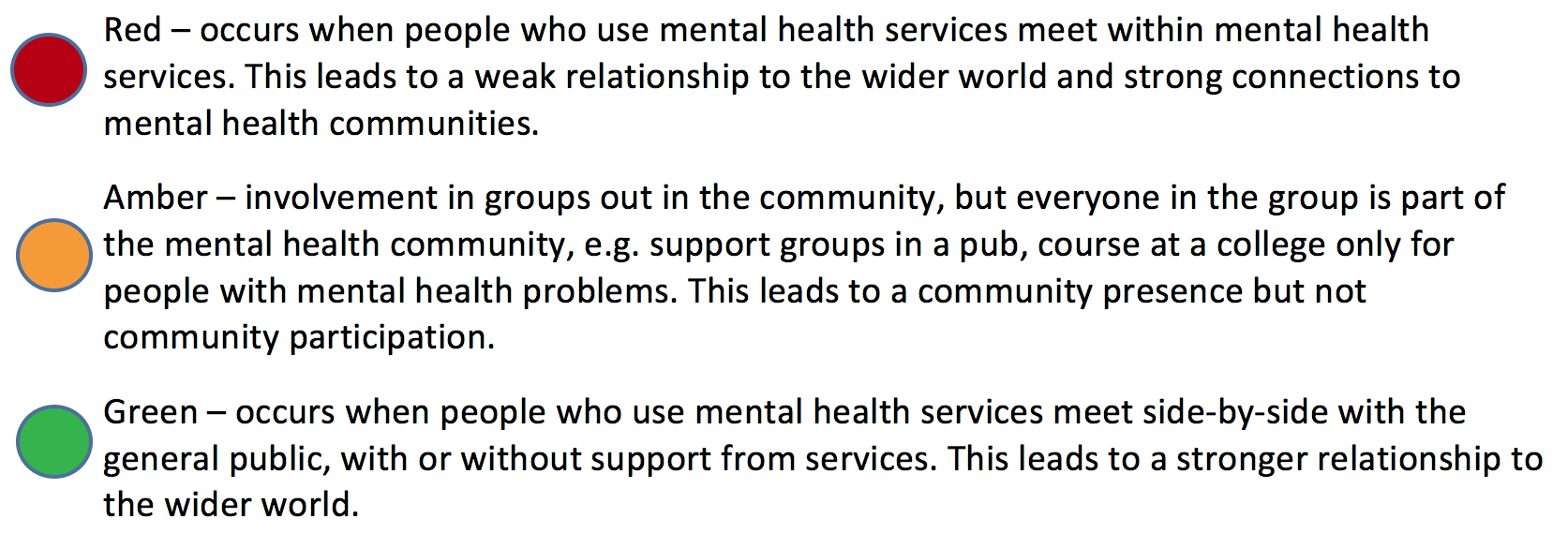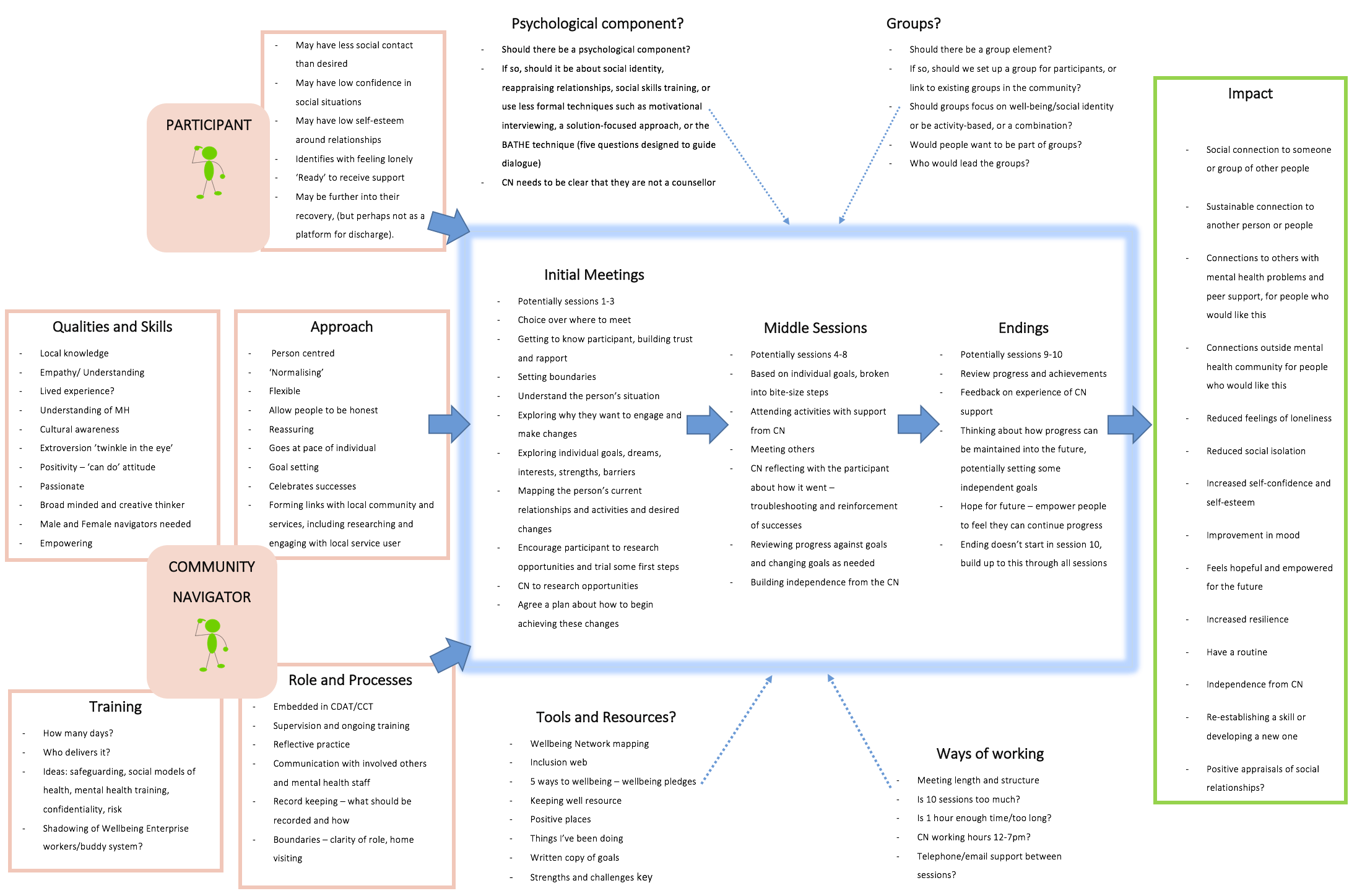Thinking about community inclusion: Community Navigator Study Working Group Meeting 3
By Kate C Fullarton, on 17 August 2016
The third meeting started with reflections on our last meeting – with discussion of Wellbeing Enterprises central to the discussion. Key thoughts of group members included how effective simple questions like ‘What is most important to you right now?’ can be, the importance of making programme materials clear and visually appealing and further consideration of the merits of short, focused, 45 minute goal-setting sessions. Perhaps the most lasting impression was the importance of community navigators having an infectious ‘can do’ attitude.
In sharing our thoughts, it is clear that we all want to create something that is flexible, person-centred, and speaks to the needs of those who feel isolated in a way that is helpful and empowering. To get us thinking further about how we might achieve this, we heard from Peter Bates, who is an Associate for the National Development Team for Inclusion working to link people with disabilities, and people with mental health needs, in to their communities.
Peter spoke about the importance of helping people move beyond mental health systems, to create an identity which isn’t based on having a mental health problem, but instead draws on people’s talents, strengths, and meaningful relationships with people around them. He spoke about three elements that can prevent inclusion:
The individual – for example whether or not a person feels confident or safe enough to be a part of their community, or whether they have the necessary financial and practical resources
The community – whether the community is welcoming and makes appropriate adjustments for people with additional needs
The mental health system – the extent to which mental health services believe that people are capable of achieving things such as returning to work and other goals, and the extent to which services give people opportunities to try things out
He got us all thinking by reminding us of the importance of the community. We often focus on ‘fixing’ the individual, but at least as important is that the community is inclusive. This struck a chord with members of the group, who gave examples of how social isolation can arise if places are unfriendly, or because they are difficult to access. There was agreement with Peter that it would be important for the community navigators to become skilled at finding out the ‘feel’ or ‘ethos’ of a place.
Peter went on to speak in more detail about what it means to be included in a community. He suggested that there was fundamental difference between being visible in a community, for instance, going for a coffee with an occupational therapist, and actually being part of that community. Though services may support people to have a community presence, they may be less equipped to support people to form meaningful and sustainable relationships within their communities. This was a useful reminder of why the community navigator roles may be so important.
The discussion became particularly animated as Peter introduced the ‘Inclusion Traffic Light’ as a framework to use when thinking about how the navigators can encourage genuine community inclusion:

However, some members of the group felt it was really important to highlight the value of people making friends within services, and how useful these friendships can be for support. Others, however, felt that where possible, aiming to have at least some ‘green’ involvement in the community was positive and should be encouraged. Peter reiterated that this is just a framework and acknowledged the value of all of these types of activities, the purpose of this framework is to serve as a reminder of the difference between involvement and wider community inclusion.
Bringing it back to the community navigator project, we considered how these ideas might impact the design of the support programme, specifically, the decision about whether we set up our own groups for participants to attend, or whether the focus is on supporting participants to attend existing community activities. On the one hand, focusing on groups and activities that are already running in the community may increase the likelihood that community navigators support people to engage in ‘green’ contact with others in their community, and it is likely to be more sustainable, as these groups or activities will continue to run after the research trial is complete. However, for some participants, who have long-term anxiety and/depression, being around people who been through similar situations may help them to feel confident to interact and form relationships. This could be the first steps towards building a less lonely and more connected life. What do you think? Should we set up our own groups? If you do, what sort of group should it be? And where should the groups take place? Let us know your thoughts below!
Next, we heard from one of the members of our group, who works at the Complex Depression, Anxiety and Trauma (CDAT) service in Camden and Islington, about the challenges that people accessing their service commonly face with social engagement. These ranged from practical considerations, such as money, travelling by public transport and availability of activities, to factors to do with symptoms, such as high anxiety, low motivation and energy and beliefs about other people, for instance, that they won’t be welcoming and they will be judgemental. Key, was a lack of confidence – about what to say and do around others, about not being good enough at the activity, about what to reveal about themselves and their mental health problems, and the feeling that others won’t want to be around them or be friends with them. Once more, hearing this context, made us step back and consider how we make the community navigator support relevant to the people we are designing the programme for, so that it has the greatest likelihood of having a real impact on reducing people’s loneliness.
To finish the session, we completed an exercise in which we mapped out how ten sessions could be used by the community navigator and participant. The model below illustrates our current thinking:

People had a clear sense of what the first three sessions would involve: the navigator and participant getting to know one another, goal setting and producing a plan about how these goals could be achieved. It was felt that later sessions needed to be more fluid, to take into account different goals, interests and progress. Nevertheless, there was agreement that these sessions might involve the community navigator supporting the person to choose and access activities, attending activities alongside the individual and after the activity, discussing how it went. The last couple of sessions would prepare for the ending of the community navigators support, focusing on reviewing progress and perhaps setting some further goals which could be completed independently, to sustain the changes made.
Next week we will look specifically at three key decisions: 1) whether we set up groups as part of the study, and if so, the form these would these take 2) the psychological approach used in the study and 3) the use of mapping and other tools. Looking at the model so far, what do you think would work best? Let us know your thoughts below, or get in contact with Kate via k.fullarton@ucl.ac.uk if there’s anything else you want to know.
 Close
Close

